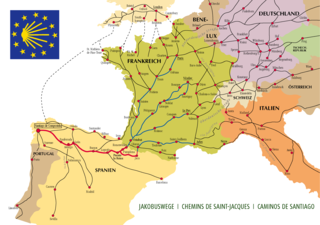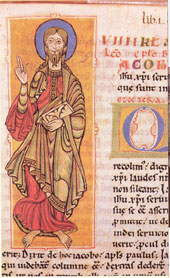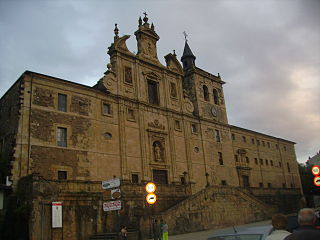
Santiago de Compostela or Compostela is the capital of the autonomous community of Galicia, in northwestern Spain. The city has its origin in the shrine of Saint James the Great, now the Cathedral of Santiago de Compostela, as the destination of the Way of St. James, a leading Catholic pilgrimage route since the 9th century. In 1985, the city's Old Town was designated a UNESCO World Heritage Site.

James the Great was one of the Twelve Apostles of Jesus. According to the New Testament, he was the second of the apostles to die, and the first to be martyred. Saint James is the patron saint of Spain and, according to tradition, his remains are held in Santiago de Compostela in Galicia.

The Camino de Santiago, or in English the Way of St. James, is a network of pilgrims' ways or pilgrimages leading to the shrine of the apostle James in the cathedral of Santiago de Compostela in Galicia in northwestern Spain, where tradition holds that the remains of the apostle are buried.

The Via Francigena is an ancient road and pilgrimage route running from the cathedral city of Canterbury in England, through France and Switzerland, to Rome and then to Apulia, Italy, where there were ports of embarkation for the Holy Land. It was known in Italy as the "Via Francigena" or the "Via Romea Francigena". In medieval times it was an important road and pilgrimage route for those wishing to visit the Holy See and the tombs of the apostles Peter and Paul.

Ponferrada is a city of Spain, located in the autonomous community of Castile and León. Ponferrada, the second most populated municipality of the Province of León, is also the capital city of El Bierzo, the only comarca recognized as an administrative entity by law in the region.

Cees Nooteboom is a Dutch novelist, poet and journalist. After the attention received by his novel Rituelen, which received the Pegasus Prize, it was the first of his novels to be translated into an English edition, published in 1983 by Louisiana State University Press of the United States. LSU Press published his first two novels in English in the following years, as well as other works through 1990. Harcourt and Grove Press have since published some of his works in English.

Luzaide is a town in Navarre, northern Spain, located on the French border and just a few kilometers from the road frontier in the French village of Arnéguy.

The Codex Calixtinus is a manuscript that is the main witness for the 12th-century Liber Sancti Jacobi, a pseudepigraph attributed to Pope Calixtus II. The principal author or compiler of the Liber is thus referred to as "Pseudo-Calixtus", but is often identified with the French scholar Aymeric Picaud. Its most likely period of compilation is 1138–1145.

The University of Santiago de Compostela - USC is a public university located in the city of Santiago de Compostela, Galicia, Spain. A second campus is located in Lugo, Galicia. It is one of the world's oldest universities in continuous operation.

The Camino de Santiago, also known as the Way of St. James, extends from different countries of Europe, and even North Africa, on its way to Santiago de Compostela and Finisterre. The local authorities try to restore many of the ancient routes, even those used in a limited period, in the interest of tourism.
The Confraternity of Saint James is a pilgrims' association, educational charity and book publisher for the ancient and modern-day pilgrim route Camino de Santiago or "way of Saint James" to the city of Santiago de Compostela in Galicia in northern Spain.

The French Way follows the GR 65 and is the most popular of the routes of the Way of St. James, the ancient pilgrimage route to Santiago de Compostela in Galicia, Spain. It runs from Saint-Jean-Pied-de-Port on the French side of the Pyrenees to Roncesvalles on the Spanish side and then another 780 km on to Santiago de Compostela through the major cities of Pamplona, Logroño, Burgos and León. A typical walk on the Camino francés takes at least four weeks, allowing for one or two rest days on the way. Some travel the Camino on bicycle or on horseback.
Juan de Ortega, better known as Saint John the Hermit, was a Spanish priest and hermit. A disciple of Dominic de la Calzada, he is best known for repairing roads and bridges along the Camino de Santiago. He also built a hospice as a shelter for pilgrims and founded the monastery of San Juan de Ortega.

The Milky Way is a 1969 comedy-drama film directed by Luis Buñuel. It stars Laurent Terzieff, Paul Frankeur, Delphine Seyrig, Georges Marchal and Michel Piccoli. Buñuel later called The Milky Way the first in a trilogy about "the search for truth."

Villafranca del Bierzo is a village and municipality located in the comarca of El Bierzo, in the province of León, Castile and León, Spain.

Christianity has a strong tradition of pilgrimages, both to sites relevant to the New Testament narrative and to sites associated with later saints or miracles.

Lost Paradise is a 2004 novel by the Dutch writer Cees Nooteboom. It tells the story of two Brazilian women who move to Australia, and of a Dutch middle-aged critic who goes to an Alpine spa.

A pilgrims' way or pilgrim way is a standard route that pilgrims take when they go on a pilgrimage in order to reach their destination – usually a holy site or place of worship. These sites may be towns or cities of special significance such as Jerusalem, Rome, Santiago de Compostela, Fátima, Lourdes or Einsiedeln, but may also be specific points in the countryside, such as a hill, spring, well, cave or shrine. On the route there are stations where pilgrims can stop and rest, where prayers may be said or religious services observed.
The Primitive Way is one of the paths of the Camino de Santiago. It begins in the old Asturian capital of Oviedo and runs west to Lugo and then south to Santiago de Compostela joining the more popular French Way in Melide for the last two hiking days. According to the Confraternity of St James, the Camino Primitivo is approximately 320 km in length.

The Routes of Santiago de Compostela: Camino Francés and Routes of Northern Spain is a UNESCO World Heritage Site located in Spain. It was designated in 1993, and later expanded and renamed in 2015. The complete site includes a network of five traditional pilgrimage routes of the Way of Saint James as it passes through Northern Spain: the popular French Way, the Primitive Way, the Northern or Coastal Way, the Interior Way and the Liébana Route; as well as 16 of the most "culturally significant" individual structures, including religious and civil buildings.
















